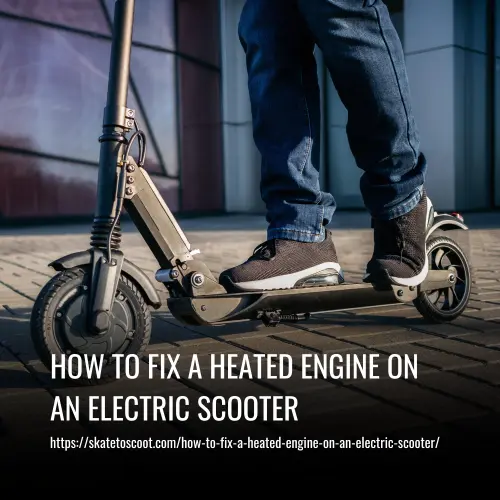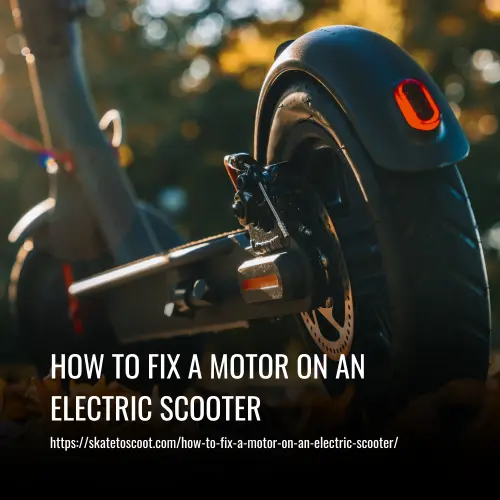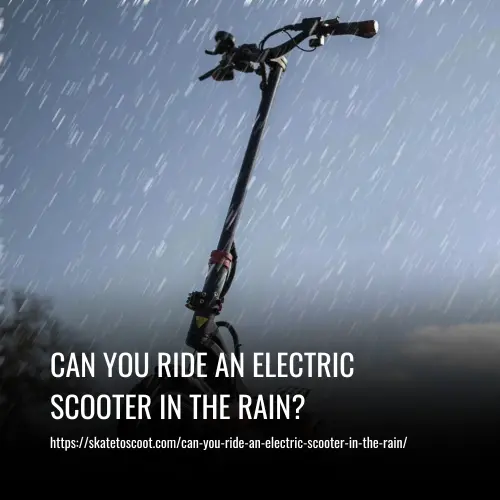As an Amazon Associate we earn from qualifying purchases.
Dealing with a heated engine on your electric scooter can be a frustrating and potentially dangerous issue. Excessive heat can damage vital components and drastically reduce the performance and lifespan of your scooter. However, there are several common reasons for a heated engine that can be addressed and fixed with proper troubleshooting and maintenance.
In this article, we will explore some of the most common causes of overheating on electric scooters and provide step-by-step instructions on how to fix them. Whether it’s loose wires, a faulty speed controller, or a defective battery, understanding the underlying issues can help you keep your electric scooter running smoothly and safely.
By implementing these troubleshooting techniques and conducting regular maintenance, you can prevent further damage and ensure optimal performance on your electric scooter. Let’s dive in and learn how to fix a heated engine on an electric scooter.

How to Fix a Heated Engine on an Electric Scooter: A Step-by-Step Guide
A heated engine is a common issue faced by electric scooter owners, but it can be fixed with proper maintenance and troubleshooting. Here we will provide some tips and steps to help you fix a heated engine on your electric scooter.
1. Regular Testing
Regular testing is essential to ensure the good health of your electric scooter. Take your scooter to a mechanic to check its battery, motor, switches, brakes, and other components. This will help identify any potential issues and prevent overheating damage.
2. Maintenance Programs
If your mechanic detects any problems during testing, it is crucial to address them promptly. Ignoring issues can cause further damage to both you and your scooter. Always keep your battery charged to prevent corrosion and extend its life. Additionally, regularly clean the scooter’s exterior and adjust your riding habits to maintain its condition.
3. Keep a Cool Charging Environment
To prevent overheating during charging, it is important to ensure your scooter is charging in a cool environment. Although some electric scooter manufacturers install cooling fans, dirt and dust can accumulate on the fan’s blades, reducing airflow and leading to more overheating. Keep the charging area clean and well-ventilated.
4. Regular Battery Check
Regularly check your scooter’s battery to ensure it is properly charged and not experiencing any overheating. Checking the battery weekly can help reduce the chance of overheating and potential breakdowns. Charge the battery when it is running low to avoid a dry run.
5. Monitor Charging Time
Take note of the charging time to prevent overcharging the battery, which can lead to overheating. By monitoring the charging time, you can also identify if the battery is damaged or not performing optimally.
6. Prevent High-Temperature Exposure
During hot weather, high temperatures can cause overheating and potential power outages. To prevent this, park your scooter in the shade and avoid riding during the hottest part of the day. High temperatures can also lead to the battery losing water and becoming damaged.
Can Electric Scooter Engine Overheat
Electric scooters are prone to overheating, especially in hot weather or when used for extended periods. There are several signs that indicate your scooter’s engine may be overheating. Firstly, if the battery feels hot to the touch, it is a clear indication of excessive heat.
Secondly, if the motor struggles to turn on or experiences acceleration issues, it may be a result of excessive engine heat. Thirdly, if there is an odd smell coming from the vents, it could be a sign of overheating.
Lastly, if you feel like something is getting too hot on the scooter, it should not be ignored. In such cases, it is advised to give the scooter a break and let it cool down. If you are unsure, it is always best to consult with a professional before further use.
Reasons For Electric Scooter Engine Overheating
Electric scooters are a convenient mode of transportation, but they can be prone to engine overheating. Understanding the reasons behind this issue is crucial to prevent damage and ensure the scooter’s longevity. Here are some common causes for electric scooter engine overheating:
1. Faulty Speed Controller
A faulty speed controller can disrupt the regulation of power going into the battery pack. This can cause the motor to work under excessive stress, leading to overheating. Regularly inspect and maintain the speed controller to avoid such issues.
2. The Wrong Voltage Supply
Inadequate voltage supply can result in system malfunctions and engine overheating. Insufficient power delivery from battery cells can cause the motor to work harder, generating excessive heat. Ensure that your electric scooter is receiving the correct voltage supply to prevent overheating.
3. A Poor Surrounding Environment
Operating an electric scooter in hot weather or dusty conditions can contribute to engine overheating. High temperatures and dust particles can block airflow and clog the motor, impeding its cooling capabilities. Choose riding environments that are suitable for your scooter and regularly clean the motor to avoid overheating.
4. Improper Use
Using the scooter’s motor improperly, such as running it continuously for extended periods, can lead to overheating. Some motors are designed for intermittent use and require cooling down between cycles. Follow the manufacturer’s guidelines on motor usage to prevent overheating issues.
5. Lack of Ventilation
Insufficient air circulation around the motor can result in heat buildup and premature failure. Ensure that there is enough space around the scooter to allow proper ventilation. Avoid obstructing airflow by placing objects too close to the motor.
6. Faulty Battery Charger
A faulty battery charger that outputs excessive voltage can cause overheating in the electric scooter. The extra voltage can damage the battery and other electronic components, leading to overheating. Always check the charger’s functionality and voltage output to avoid potential issues.
7. Problem with the Battery Itself or a Dead Battery
A dying or defective battery can cause the electric scooter to overheat. If you experience excessive heat and the scooter does not turn on despite being charged, it may be a sign of a battery issue. Consult a professional to diagnose and replace the battery if necessary.
8. Blown or Flipped Fuse
If your scooter fails to start or the ignition fuse keeps flipping, it can contribute to overheating. Check the fuse and replace it if needed to restore normal scooter functionality.
9. Runs for a Short Time
If your scooter runs for only a short time after being fully charged, it could indicate degraded batteries. Monitoring battery backup and charging regularly can help prevent overheating caused by diminished battery capacity.
10. No or Weak Acceleration
Weak acceleration, coupled with engine overheating, may be due to a blown or flipped switch problem. Verify the switch settings and rectify any issues to ensure proper power flow to the motor.
What Happens if an Electric Scooter Engine Overheats
When an electric scooter engine overheats, it can lead to various issues and potentially damage the scooter. Signs of overheating include sparks near the battery pack and a boiling hot battery pack. If you suspect overheating, it is essential to unplug the charger, turn off the power switch, and allow the scooter to cool down before attempting to ride it.
Riding an overheated scooter can cause severe burns or injuries. Additionally, checking the indicator light on the battery charger can help determine if the scooter is overheating. If the indicator light is orange or red, it may indicate overheating. Monitoring for these signs and taking appropriate actions can prevent further damage and ensure the scooter’s safety.
Safety Consideration When Electric Scooter Engine Overheated
Excessive engine heat can be a common issue with electric scooters, but it’s important to address it promptly to prevent further damage.
1. Turn it Off and Let it Cool Down
As a safety precaution, switch off your electric scooter immediately when you notice that the engine is overheating. Allow it to cool down completely before attempting any repairs.
2. Check the Wiring, Fuse, or Electrical Controller
Once the scooter has cooled down, inspect the wiring, fuse, and electrical controller for any visible issues. Look for loose or frayed wires, blown fuses, or malfunctioning electrical controllers. These components can contribute to engine overheating.
3. Call a Technician
If you identify any wiring, fuse, or electrical controller problems, it is best to call a professional technician or an electric scooter repair shop. They have the knowledge and expertise to fix these complex electrical issues and ensure a safe repair.
4. Temporarily Avoid Riding
While waiting for the issue to be resolved, it is advisable to avoid riding your electric scooter as a precautionary measure. Continuing to use the scooter with an overheated engine can potentially worsen the problem and cause further damage.
FAQs
No, it is not recommended to overcharge an electric scooter. Overcharging can lead to damage to the battery cells and reduce their overall lifespan. It is important to follow the manufacturer’s guidelines for charging time and avoid leaving the scooter plugged in for longer than necessary.
Charging an electric scooter overnight is generally safe if the scooter has a built-in charging management system. However, it is still advisable to keep an eye on the charging process and avoid leaving the scooter unattended for long periods while charging.
Electric scooters produce zero tailpipe emissions, making them a greener alternative to traditional gas-powered scooters. They run on electricity, which can be generated from renewable sources, further reducing their carbon footprint.
Conclusion
In conclusion, addressing a heated engine issue on an electric scooter requires a systematic approach and a proper understanding of the underlying causes. By identifying and resolving common issues such as loose wires, faulty speed controllers, or depleted batteries, riders can prevent excessive heat buildup in the engine.
Regular maintenance, including checking wire connectors, inspecting battery cells, and ensuring the proper functioning of electronic components like the power switch or ignition fuses, is crucial for optimal performance and safety.
Ultimately, proactive troubleshooting, prompt identification of issues, and timely repairs can enhance the lifespan and overall performance of electric scooters.
Amazon and the Amazon logo are trademarks of Amazon.com, Inc, or its affiliates.



